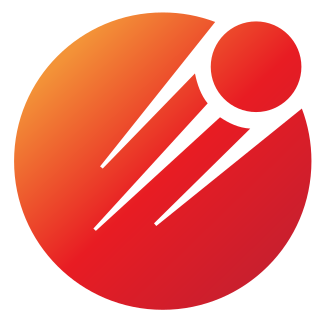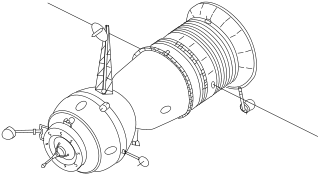
Soyuz is a family of expendable Russian and Soviet carrier rockets developed by OKB-1 and manufactured by Progress Rocket Space Centre in Samara, Russia. With over 1,900 flights since its debut in 1966, the Soyuz is the rocket with the most launches in the history of spaceflight.

PAO S. P. Korolev Rocket and Space Corporation Energia, also known as RSC Energia, is a Russian manufacturer of spacecraft and space station components. The company is the prime developer and contractor of the Russian crewed spaceflight program; it also owns a majority of Sea Launch. Its name is derived from Sergei Korolev, the first chief of its design bureau, and the Russian word for energy.

Plesetsk Cosmodrome is a Russian spaceport located in Mirny, Arkhangelsk Oblast, about 800 km north of Moscow and approximately 200 km south of Arkhangelsk, the cosmodrome dates to 1957. Originally developed as an ICBM site for the R-7 missile, it also served for numerous satellite launches using the R-7 and other rockets. Its high latitude makes it useful only for certain types of launches, especially the Molniya orbits, so for much of the site's history it functioned as a secondary location, with most orbital launches taking place from Baikonur, in the Kazakh SSR. With the end of the Soviet Union, Baikonur became a foreign territory, and Kazakhstan charged $115 million usage fees annually. Consequently, Plesetsk has seen considerably more activity since the 2000s.

Soyuz 12 was a September, 1973, crewed test flight by the Soviet Union of the newly redesigned Soyuz 7K-T spacecraft that was intended to provide greater crew safety in the wake of the Soyuz 11 tragedy. The flight marked the return of the Soviets to crewed space operations after the 1971 accident. The crew capacity of the capsule had been decreased from three to two cosmonauts to allow for pressure suits to be worn during launch, re-entry and docking. It was the first time pressure suits were used for reentry since the Voskhod 2 flight.
Kosmos is a designation given to many satellites operated by the Soviet Union and subsequently Russia. Kosmos 1, the first spacecraft to be given a Kosmos designation, was launched on 16 March 1962.
Soyuz T-9 was the 4th expedition to Salyut 7 following the failed docking of Soyuz T-8. It returned lab experiments to Earth. The next mission, Soyuz 7K-ST No.16L, had exploded and thus failed to launch.
Kosmos 140, Soyuz 7K-OK No.3, was an uncrewed flight of the Soyuz spacecraft. It was the third attempted test flight of the Soyuz 7K-OK model, after orbital and launch failures of the first two Soyuz spacecraft.
Kosmos 670 was an unmanned Soyuz 7K-S test. It used a new and unique inclination of 50.6 degree. The experience from these flights were used in the development of the successor program Soyuz spacecraft the Soyuz 7K-ST.

Soyuz-2 is a modernised version of the Soviet Soyuz rocket. In its basic form, it is a three-stage launch vehicle for placing payloads into low Earth orbit. Compared to the previous versions of the Soyuz, the first-stage boosters and two core stages feature uprated engines with improved injection systems. Digital flight control and telemetry systems allow the rocket to be launched from a fixed launch platform, whereas the launch platforms for earlier Soyuz rockets had to be rotated as the rocket could not perform a roll to change its heading in flight.

The Soyuz 7K-L1 "Zond" spacecraft was designed to launch cosmonauts from the Earth to circle the Moon without going into lunar orbit in the context of the Soviet crewed Moon-flyby program in the Moon race. It was based on the Soyuz 7K-OK. Several modifications reduced vehicle mass and increased circumlunar capability. The most notable modifications were the replacement of the orbital module with a support cone and a high-gain parabolic antenna, the removal of a reserve parachute, and the addition of the gyro platform and star navigation sensors for the far space navigation. The spacecraft was capable of carrying two cosmonauts. At the start of flight testing, there were serious reliability problems with the new Proton rocket, the 7K-L1, and the Soyuz 7K-OK that the L1 was based on.

The second generation of the Soyuz spacecraft, the Soyuz 7K-T, comprised Soyuz 12 through Soyuz 40 (1973–1981). In the wake of the Soyuz 11 tragedy, the spacecraft was redesigned to accommodate two cosmonauts who would wear pressure suits at all times during launch, docking, undocking, and reentry. The place of the third cosmonaut was taken by extra life-support systems. Finally, the 7K-T, being intended purely as a space station ferry, had no solar panels, instead sporting two large whip antennas in their place. As a result, it relied on batteries which only provided enough power for two days of standalone flight. The idea was that the Soyuz would recharge while docked with a Salyut space station, but in the event of a docking or other mission failure, the crew was forced to power off everything except communications and life support systems until they could reenter.
Kosmos 2175 was a Russian Yantar-4K2 photo reconnaissance satellite. It was the first satellite to be launched by the Russian Federation, following the breakup of the Soviet Union. It was launched by a Soyuz-U carrier rocket, flying from the Plesetsk Cosmodrome, on 21 January 1992.
The Soyuz-U2 was a Soviet, later Russian, carrier rocket. It was derived from the Soyuz-U, and a member of the R-7 family of rockets. It featured increased performance compared with the baseline Soyuz-U, due to the use of syntin propellant, as opposed to RP-1 paraffin, used on the Soyuz-U.

Soyuz TMA-22 was a crewed spaceflight to the International Space Station (ISS). TMA-22 was the 111th flight of a Soyuz spacecraft, and transported three members of the Expedition 29 crew to the ISS. The spacecraft docked to the ISS on 16 November 2011, and remained docked to serve as an emergency escape vehicle until its undocking on 27 April 2012. Soyuz TMA-22 successfully landed in Kazakhstan on 27 April 2012 11:45 GMT.

Progress M-08M, identified by NASA as Progress 40P, is a Progress spacecraft which was used to resupply the International Space Station. It was the eighth Progress-M 11F615A60 spacecraft to be launched, the fifth for the year 2010. The spacecraft was manufactured by RKK Energia, and was operated by the Russian Federal Space Agency. It arrived at the space station on 30 October 2010 whilst the Expedition 25 crew was aboard, and departed during Expedition 26 on 24 January 2011.
The National Space Agency of the Republic of Kazakhstan, also known as KazCosmos, or KazKosmos, is Kazakhstan's national space agency, and was officially established on 27 March 2007.

Kosmos 2480 is a Russian Kobalt-M reconnaissance satellite which was launched in 2012 by the Russian Aerospace Defence Forces. It was the last launch of a Soyuz-U rocket launched from Plesetsk Cosmodrome.

Progress MS-01, identified by NASA as Progress 62P was a Progress spaceflight operated by Roscosmos to resupply the International Space Station (ISS) in 2015. It was launched on 21 December 2015, to deliver cargo to the ISS. Progress MS-01 is the first vehicle in the Progress-MS series.
Kosmos 154, also known as L-1 No.3P, was a Soviet test spacecraft launched from the Baikonur aboard a Proton-K rocket. It was a prototype Soyuz 7K-L1 launched by Proton. It was an uncrewed precursor to the Zond series.
Zond program was a Soviet robotic spacecraft program launched between 1964 and 1970, using two spacecraft series, one for interplanetary exploration, and the other for lunar exploration.










